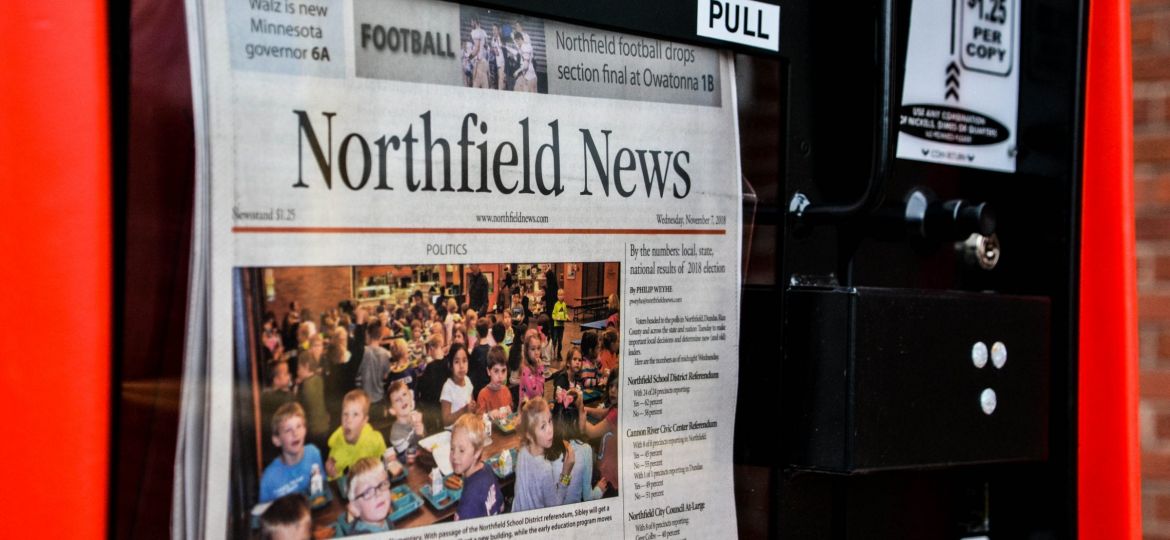
Southern Minnesota newspapers have suffered from increases in printing costs following the Trump administration’s decision to place tariffs on Canadian newsprint in January 2018.
Northfield News and the Manitou Messenger, both users of Cannon Valley Printing, have experienced an increase in printing prices following the imposition the tariffs.
The tariffs’ effects are not limited to Northfield publications but have affected papers across Southern Minnesota, Chad Hjellming, Regional General Manager at Southern Minnesota Media, said.
“Northfield News is included in that,” he said. “I don’t know the exact numbers but the numbers that are being thrown around are 25-30 percent increase in paper costs.”
The Manitou Messenger has also seen a rise in in printing costs, according to Sydney Wagner ’21, Business Manager for the Manitou Messenger. Wagner estimates that costs have increased by $7 per issue, or $147 over the course of the school year.
After the initial increase, printing costs are expected to slowly decrease after the United States International Trade Commission (ITC) eliminated the paper tariffs on Aug. 29.
“The ITC is bipartisan, a federal agency, and they only have about 4 or 5 people on a board that are making these decisions, whether the tariffs are just or not,” St. Olaf Assistant Professor of political science Menevis Cilizoglu said.
The ITC’s decision stemmed from their finding that Canadian newsprint imports did not materially hurt any domestic industries.Even though the ITC blocked the tariffs, paper prices are not expected to decrease quickly.
“I doubt it will ever go back to what it used to be in cost,” Hjellming said. He expects, however, it will take some time for printing costs to decrease.
“This simply means that the tariffs decision will be reversed, and the Canadian companies who used to sell their goods in the US tax free, they can continue to do so,” Cilizoglu said. “So I would expect that that will lead to a reduction in prices and going back to the normal, to what it used to be before the tariffs were imposed.”
Cilizoglu said that the tariffs would benefit domestic manufacturers while harming firms that purchase from these companies.
“The manufacturers that are being benefited are the paper mills, so they benefit from the policy because they don’t have to compete against the Canadian [paper mills],” Cilizoglu said. “But for all the businesses that buy from them, the prices will go up due to a decrease in competition.”
Northfield News developed some strategies for saving money in response to the rise in printing costs that do not affect distribution or circulation.
“Our subscribers don’t get hurt,” Hjellming said. “But where it has hurt us is that [at] times we have to cut back on the number of pages we’re printing. What would have been 16 to 20 pages on the weekend, now that’s down to 8-12.”
Digital news might play a role in the cost increase.
“There’s the discussion about all the other reasons why prices might go up, decrease in demand for print newspapers,” Cilizoglu said. “Probably the tariffs are not the entire story here.”
Northfield News has a digital platform which they are hoping to expand.
“We’re evolving [our digital platforms], and we know that it’s something we need to do better, to engage with an online audience,” Hjellming said. “We’re growing our digital subscriptions year after year, which is a good thing. We’ve instituted a paywall on our website, last year, which has helped grow that area of our subscription. So we’ve seen growth on the digital side, which is a very good thing, but it hasn’t been affected by printing costs.”
However, Hjellming stills sees the benefit in print.
“We look at our printing products and see that the cost of printing is worth the amount of revenue we have within that,” Hjellming said.















